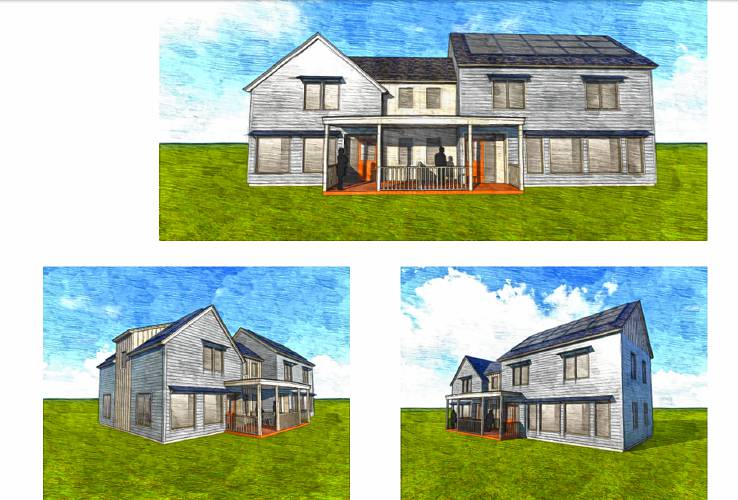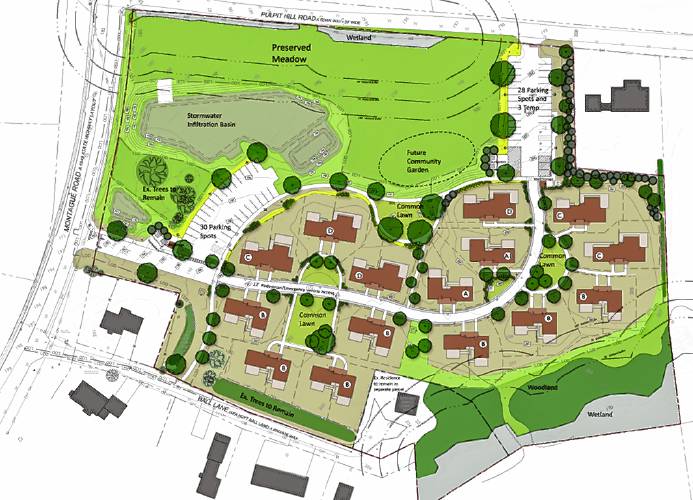30-home affordable complex in Amherst gets go-ahead
| Published: 03-19-2024 4:46 PM |
AMHERST — An affordable housing development giving 30 families an opportunity to own their own homes is on track to be constructed over the next few years after receiving a comprehensive permit from the Zoning Board of Appeals, with a condition that, during the selection process for almost one-third of the dwellings, a preference be given to those who live or work locally, or have children in the town’s public schools.
After a lengthy series of meetings beginning last October, the Zoning Board of Appeals voted unanimously last Thursday to award a comprehensive permit, with waivers, conditions and findings, to Valley Community Development so it can proceed with Amherst Community Homes, a $20 million development on just over 9 acres situated between Ball Lane and Pulpit Hill Road and just off Montague Road/ Route 63.
Ground is expected to be broken next year, with all homes to be sold by 2027, said Jessica Allan, real estate project manager for Valley CDC.
The major source of funding for the 30 homes, to be built as 15 duplexes, is MassHousing’s CommonWealth Builder program, which aims to make single-family homes and condominiums affordable for communities of color. The CommonWealth Builder program provides a subsidy for first-time homebuyers, looking to increase homeownership for Black, Indigenous and people of color (BIPOC) communities and enhance generational wealth.
In approving the development, the Zoning Board of Appeals is requiring a local preference for seven of the 10 homes that are set aside for people earning at or below 80% of the area median income. That is the maximum number of homes that can be given local preference during the lottery selection. The other 20 homes, being sold to those earning at or below 100% of the area median income, will have no similar local preference during the lottery selection.
The board voted 4-1 in support of the local preference, with board member Everald Henry opposed.
Chairman Steve Judge supported the local preference, pointing to the money the town is putting into the project, including $375,000 from the Amherst Affordable Housing Trust and $750,000 from the town’s Community Preservation Act account.
“I think it helps to provide public support for these kind of efforts,” Judge said of the local preference. But he acknowledged that such restrictions have been used to racially discriminate and to exclude people of color from housing opportunities. “I don’t think that’s the case here,” Judge said.
Article continues after...
Yesterday's Most Read Articles
Judge said there is confidence that the board is not trying to keep people out and that there should be enough BIPOC individuals and families from Amherst’s two qualified census tracts who are eligible to apply. Those qualified census tracts are considered to be placed with “disproportionately impacted households,” as defined under the federal American Rescue Plan Act legislation.
Henry, though, said he wouldn’t vote for the local preference due to the use of intentional and unintentional exclusionary practices in the past. “I will not support the local preference, even though the number is small, as clarified by Valley CDC,” Henry said.
Board member Hilda Greenbaum supported the local preference because she said she wants to make sure that current taxpayers are benefiting from affordable housing. In addition to Judge, she was joined by members Craig Meadows and Philip White in the affirmative. White said he would support the local preference because the provision affects only seven units.
Allan told the Zoning Board of Appeals that it is unusual under the CommonWealth Builder program to have such a provision, observing that active projects in places such as Roxbury and Boston, where there are higher percentages of people of color, have not used it.
“Commonwealth Builders has not seen local preference yet on a project. This is unique to this program,” Allan said.
Even with the local preference, Allan said Valley CDC will do robust marketing in qualified census tracts around the region, including the two in Amherst, as well as in Holyoke, Greenfield, Ware, Chicopee and Springfield. Allan said part of this marketing will include outreach to BIPOC-owned businesses and community groups located in Amherst and the other communities.
For the selection criteria, Allan said priorities will be appropriate size households for the units available, and then living in a qualified census tract and being a disproportionately impacted household. All chosen to buy the homes will have be income-eligible, first-time homebuyers and not have combined assets of more than $100,000.
According to a fact sheet, eligible household incomes are set by MassHousing and based on federal Housing and Urban Development household income limits and are adjusted annually. It is anticipated that sales prices will range from $150,000 for a two-bedroom, one-story home under the 80% of median income cap to $225,000 for a two-story, three-bedroom home under the 100% of median income limit.
Based on recent affordable housing developments, Allan said there will likely be many more applicants than homes available.
The site, on a PVTA bus line, once had a trucking and agricultural building that has been demolished. There will be on-site parking for residents, as well as areas left undisturbed, with about half the site remaining open space. The parcel is within walking distance of both Puffer’s Pond and Mill River Recreation Area, and is close to North Amherst center and the Mill District, with the University of Massachusetts less than two miles away.
Scott Merzbach can be reached at smerzbach@gazettenet.com.








 Five UMass Amherst students have visas, student status revoked
Five UMass Amherst students have visas, student status revoked Photo: Spring calling
Photo: Spring calling A father’s dream to be the best: Twelve men graduate from Nurturing Fathers program
A father’s dream to be the best: Twelve men graduate from Nurturing Fathers program McGovern co-sponsors bill that aims to stop ‘backdoor’ cuts to SNAP benefits
McGovern co-sponsors bill that aims to stop ‘backdoor’ cuts to SNAP benefits
